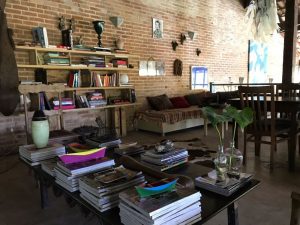São Paulo – Arab visual artists and designers may apply to participate in an art residency of four weeks in Boiçucanga, in the north coast of São Paulo. They will stay at Kaaysá Art Residency and, as social counterparts, may offer workshops with local students, community service and interaction with indigenous people from the region. The open call will award four visual artists or designers.
The open call is sponsored by the Arab Brazilian Chamber of Commerce and launched in partnership with Beirut Art Fair and Beirut Design Fair that ran in Lebanon’s capital city last week.
The selection committee will consist of Laure D’ Hauteville, founder/director of Beirut Art Fair 2019; Silvia Antibas, cultural director of the Arab Brazilian Chamber; Lourdina Jean Rabieh, founder and director of Kaaysá Art Residency; and Lucila Mantovani, coordinator of Kaaysá Art Residency.

“The artist may be from any Arab country, and we’re prioritizing young, up-and-coming artists to encourage new talents,” said Silvia Antibas. “The Arab Chamber supports the initiative to encourage the Arab-Brazilian connection as it’s the Chamber’s mission,” she added.
Application must be submitted through the email info@kaaysa.com.br. Read the full open call here.
The result of the open call will be announced on November 10 on the social media of Kaaysá Art Residency, the Arab Brazilian Chamber, Beirut Art Fair and Beirut Design Fair. The selected artists will be contacted by Kaaysá Art Residency to schedule their residency of four weeks in one of the offered programs in 2020, collective or individual, within the period of validity of one year.
About Kaaysá
Kaaysá is a temporary residency for artists and creators who wish to develop their talents near the Brazilian Atlantic Rain Forest (3 hours by car from of São Paulo), the sea and the community that inhabits its surroundings.
With individual and collective programs, the space encompasses experiences at the sea and in the forest, lectures, exchanges with artists and curators from Brazil and the world, socializing with residents and monitoring of projects by mediators. Artists are invited to leave their tracks in the space and in the village, provoking reflections, changes in the landscape and other social counterparts.
Translated by Guilherme Miranda




